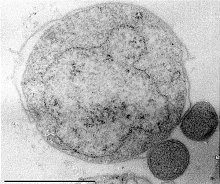| Nanoarchaeum equitans | |
|---|---|

| |
| Two Nanoarchaeum equitans cells (and its larger host Ignicoccus) | |
| Scientific classification | |
| Domain: | Archaea |
| Superphylum: | DPANN |
| Phylum: | Nanoarchaeota |
| Class: | Nanoarchaeia |
| Order: | Nanoarchaeales |
| Family: | Nanoarchaeaceae |
| Genus: | Nanoarchaeum |
| Species: | N. equitans
|
| Binomial name | |
| Nanoarchaeum equitans Huber et al. 2002
| |
Nanoarchaeum equitans is a species of marine archaea that was discovered in 2002 in a hydrothermal vent off the coast of Iceland on the Kolbeinsey Ridge by Karl Stetter. It has been proposed as the first species in a new phylum, and is the only species within the genus Nanoarchaeum. Strains of this microbe were also found on the Sub-polar Mid Oceanic Ridge, and in the Obsidian Pool in Yellowstone National Park. Since it grows in temperatures approaching boiling, at about 80 °C (176 °F), it is considered to be a thermophile. It grows best in environments with a pH of 6, and a salinity concentration of 2%. Nanoarchaeum appears to be an obligate symbiont on the archaeon Ignicoccus; it must be in contact with the host organism to survive. Nanoarchaeum equitans cannot synthesize lipids but obtains them from its host. Its cells are only 400 nm in diameter, making it the smallest known living organism, and the smallest known archaeon.
N. equitans' genome consists of a single circular chromosome, and has an average GC-content of 31.6%. It lacks almost all of the genes required for the synthesis of amino acids, nucleotides, cofactors, and lipids, but encodes everything needed for repair and replication. N. equitans contains several genes that encode proteins employed in recombination, suggesting that N. equitans can undergo homologous recombination.[1] A total of 95% of its DNA encodes for proteins or stable RNA molecules.
N. equitans has small appendages that come out of its circular structure. The cell surface is covered by a thin, lattice-shaped S-layer, which provides structure and protection for the entire cell.
- ^ Waters E, Hohn MJ, Ahel I, Graham DE, Adams MD, Barnstead M, Beeson KY, Bibbs L, Bolanos R, Keller M, Kretz K, Lin X, Mathur E, Ni J, Podar M, Richardson T, Sutton GG, Simon M, Soll D, Stetter KO, Short JM, Noordewier M (October 2003). "The genome of Nanoarchaeum equitans: insights into early archaeal evolution and derived parasitism". Proc Natl Acad Sci U S A. 100 (22): 12984–8. doi:10.1073/pnas.1735403100. PMC 240731. PMID 14566062.